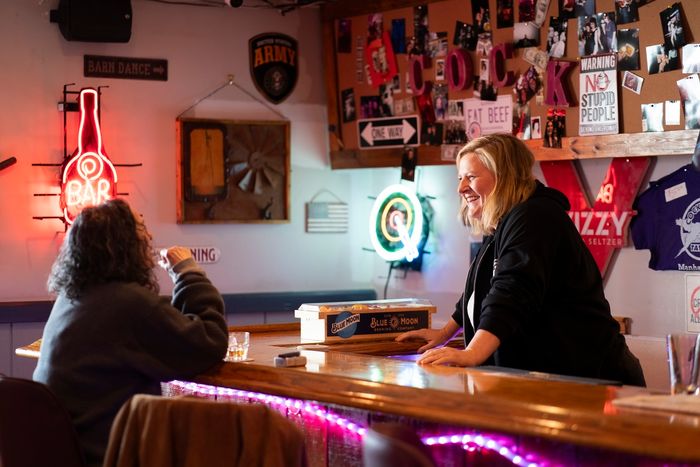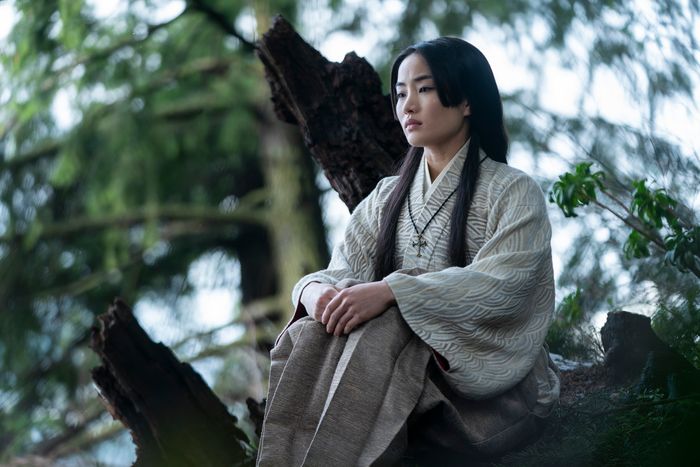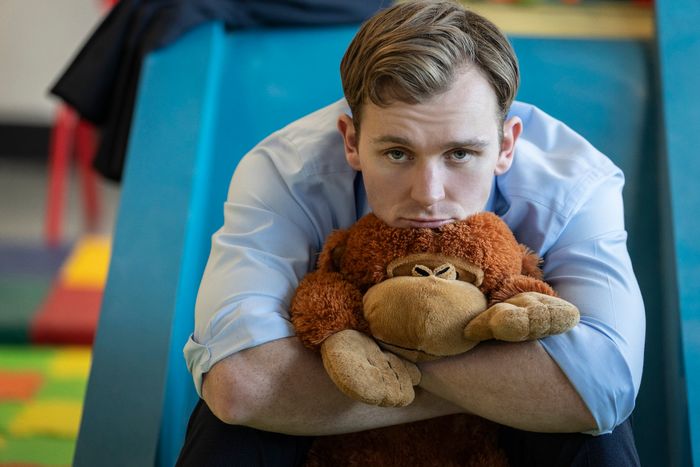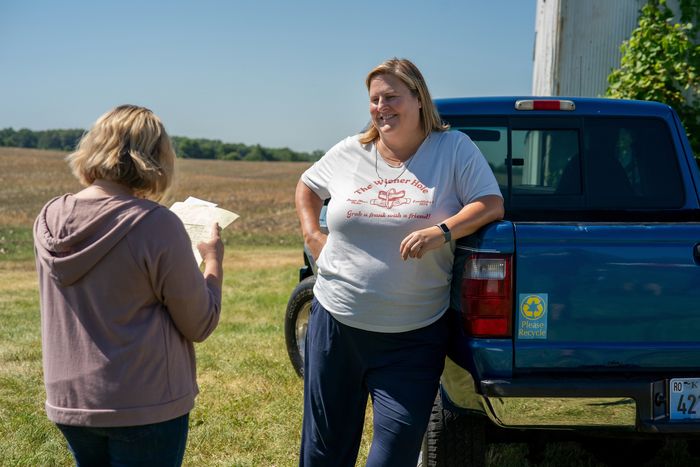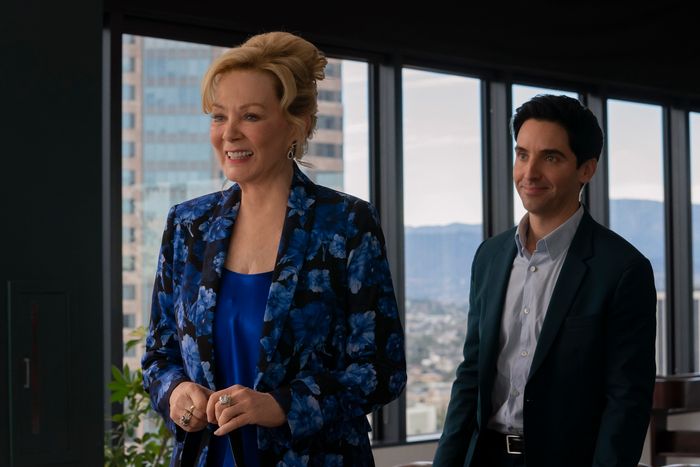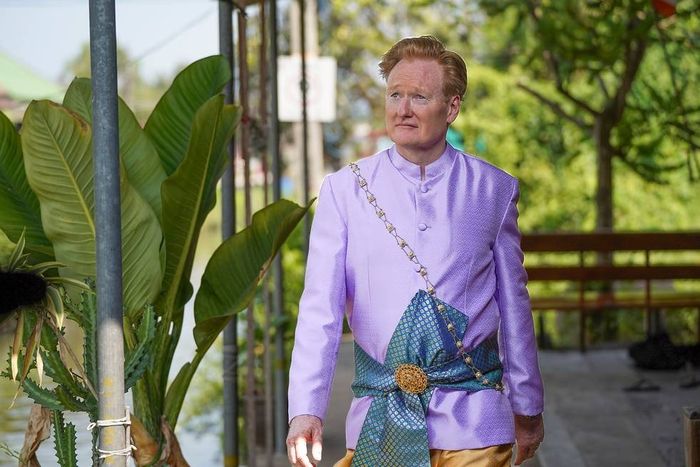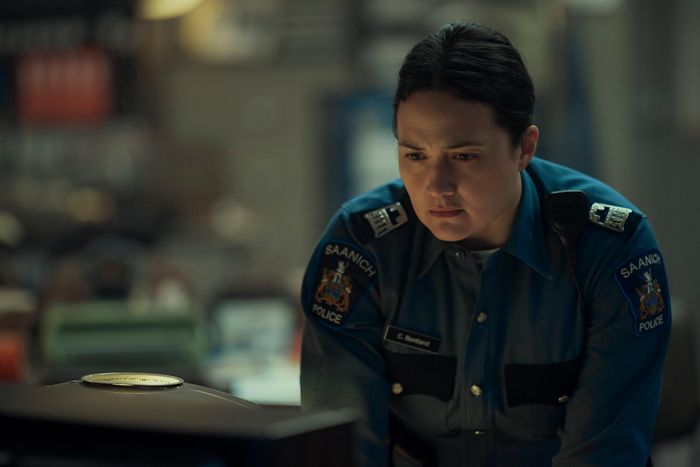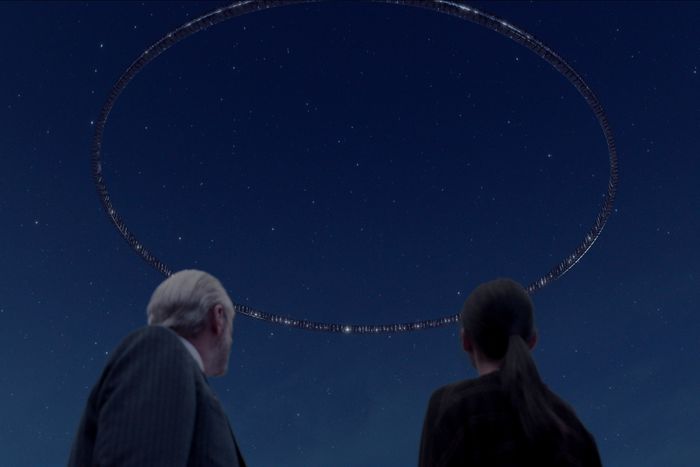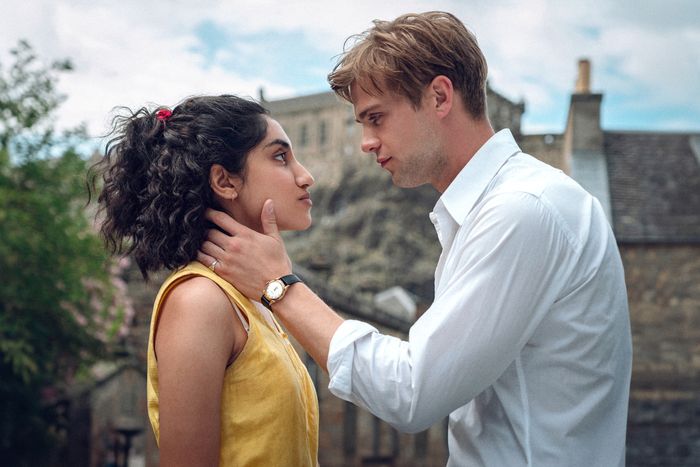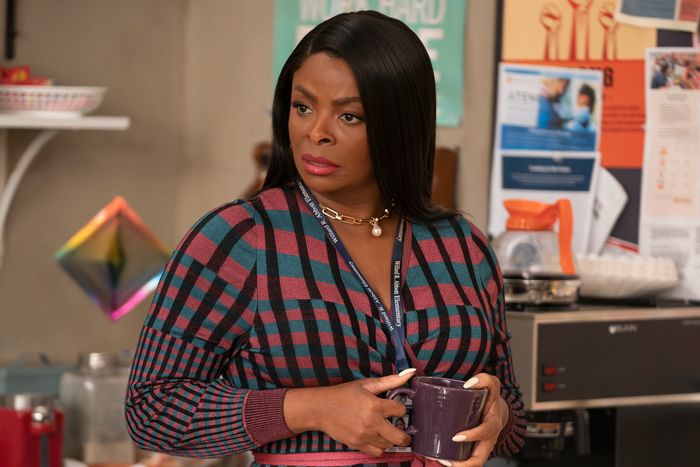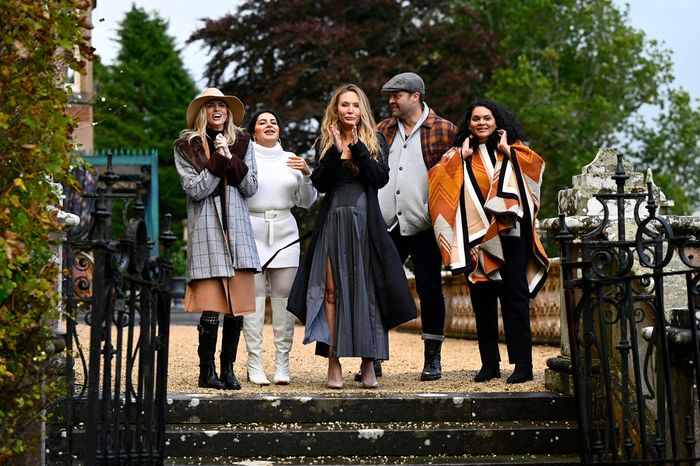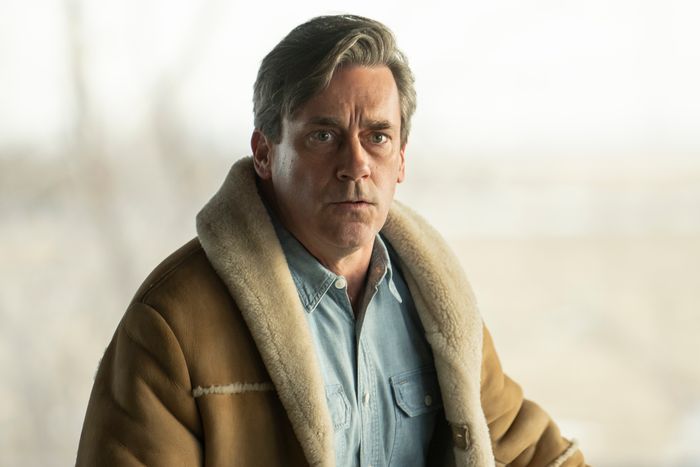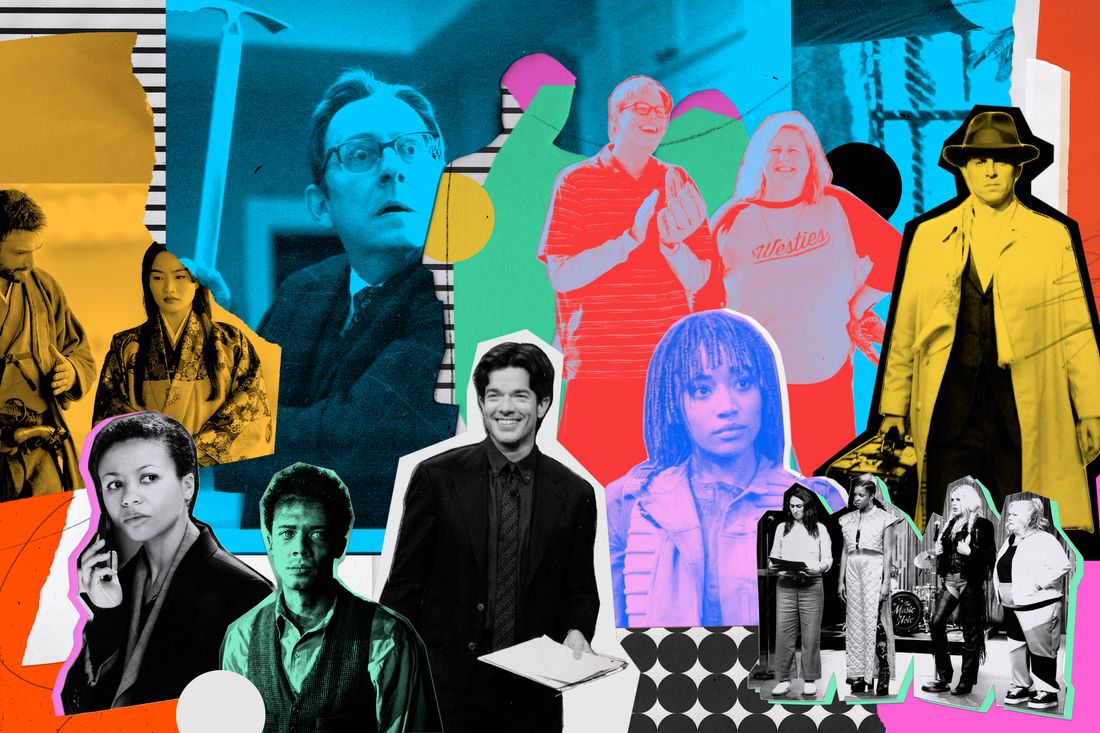
In this article
It’s that time of year again, when Vulture’s critics embark on our messiest annual tradition: the finalization of our Top 10 lists. Here are the best shows of 2024, according to TV critics Jen Chaney, Roxana Hadadi, Jackson McHenry, and Kathryn VanArendonk.
Jen Chaney’s Top 10 Shows
Anyone who makes or consumes television knew the ever-swelling bubble of more and more and more TV would eventually burst, so it wasn’t exactly shocking when FX Networks CEO John Landgraf announced in February that Peak TV was officially dead with 2023 marking the first significant decline (14 percent) in new scripted series since 2009 (not counting 2020, when fewer shows went into production because of the pandemic). And yet it was surprising how much 2024 felt like an uneventful wake for the Peak TV era. There was still great television, but there was so much more mid or meh television and far fewer exceptional offerings or moments when a critical mass of viewers seemed equally excited about the same series. Response to the third season of The Bear, one of the most beloved shows of 2023, was tepid and, in some cases, outright hostile. Shōgun and House of the Dragon both found audiences, but it never felt like those audiences were collectively discussing either drama at the same time.
Every TV professional I’ve spoken to in recent months has expressed confusion about what kinds of series networks and streamers care about in this poststrike, post-Peak landscape. That’s why I built this best-of-the-year list with an eye toward the types of projects I fear may be deprioritized in the coming months: things that are weird, idiosyncratic, and, like my top pick of 2024, Somebody Somewhere, focused on the nuances of relationships between regular people rather than superheroes or protagonists plucked from existing (exhausted) IP. This year may have confirmed that we’re past the peak in terms of the amount of television, but the works below indicate we’re still reaching new creative heights.
10.
True Detective: Night Country
Under the guidance of creator and showrunner Nic Pizzolatto, the first three seasons of True Detective, especially its first, focused mostly on men and told their stories with an explicitly male gaze that minimized or sexualized women. Then Issa López came along and created Night Country, the fourth iteration of True Detective and the most mystical, genuinely frightening installment. Recontextualizing story beats and themes from the Matthew McConaughey–Woody Harrelson season, López crafted a moody crime thriller that centers two female cops — Jodie Foster and Kali Reis, delivering equally fierce, complex performances — while exploring grief, spirituality, and the marginalization of Indigenous women. She also sets the murder investigation in frigid Ennis, Alaska, during the longest, darkest days of the dead of winter, when all the natural shadows can be mistaken (or not?) for portals to the supernatural. Where the first season of True Detective put metaphysical words in McConaughey’s mouth, each episode of Night Country immerses you in a liminal space on the edge of reality where the world and the otherworldly meet.
➼ Read our full review, interviews with star Kali Reis and showrunner Issa López, our essay on the finale, weekly “Clue Detective” series, and recaps of the season. Catch up on the rest of Vulture’s in-depth True Detective: Night Country coverage.
9.
Fantasmas
Given the caution and contraction that permeated the TV landscape this year, my appetite for risk-taking was even greater than normal. Keep your IP-driven “content” — give me weirdness! Fantasmas, starring and created, written, and directed by Julio Torres of Los Espookys and Problemista fame, satisfied that craving in a spectacularly trippy way. Technically, it’s a sketch-comedy series — a genre in desperate need of fresh oxygen — but Fantasmas also follows a serial narrative in which Torres’s Julio tries to get a “proof of existence” card that will enable him to finally legitimately rent an apartment and get a job. He also spends much of the HBO series searching for a missing earring and attempting to figure out whether a mole on his neck is cancerous. Translation: This show makes no sense at all but also makes all the sense in the world, especially after an edible. Many of the sketches highlight imbalanced power dynamics (Bowen Yang plays an elf from the North Pole who files a labor dispute against Santa) and the exploitative, absurdist nature of working in entertainment (a Real Housewives parody featuring Emma Stone, Rachel Dratch, Rosie Perez, and Cole Escola). But the best part of Fantasmas is that it’s never clear where its stream-of-consciousness flow will take it next.
8.
Bad Monkey
Adapted by Bill Lawrence from the novel by Carl Hiaasen, this Apple TV+ series could be Night Country’s B-side. It too starts as a murder mystery and tussles with spirituality, greed, and the need to protect the environment. But Bad Monkey is set in Miami, Key West, and the Bahamian island Andros and goes down like a bottle of Corona with a generous squeeze of lime. Sure, it gets stressful at times — but in a relaxed wisecracking way thanks to star Vince Vaughn, who’s so perfectly cast as a suspended cop who can’t detach from detectivework or deploying his chatterbox charms that the role seems to have been fitted to Vaughn’s form by the most gifted tailor in the greater Miami-Dade County area.
➼ Read our full review of Bad Monkey, essay on summer’s B-plus series, and interview with star Jodie Turner-Smith.
7.
Extraordinary season two
One of the great pleasures of reviewing television is discovering that a series with immense promise in its first season exceeded that promise in its second. A coming-of-age story dressed up in a high-concept, comic-book-esque structure, Extraordinary chronicles the exploits of a young Irish woman (a winning Máiréad Tyers) living in London and coping with the fact that she was not granted a superpower when she turned 18 like everyone else in society. The second season gives creator Emma Moran the latitude to go in some wild, Charlie Kaufman–like directions, taking viewers into the literal manifestation of Jen’s subconscious (a very messy used bookstore) and a restaurant called Little Italy that requires patrons to shrink so they can fit inside. (It’s actually little, you see.) Extraordinary has nothing to do with the Marvel or DC universes, yet season two emerged as the most fun, whimsical, and moving superhero story of the year.
➼ Read our full review of Extraordinary.
6.
Shōgun
This FX production — broadcast largely in Japanese with English subtitles, a rarity for mainstream TV — was ambitious on every metric one could use to evaluate television. Despite a vast narrative and visual scope, Shōgun never sacrificed the details: Its writers and directors depicted feudal Japanese culture with an eye toward ceremony and smaller gestures exchanged between sips of tea. Its excellent ensemble was equally meticulous and restrained in its performances, exemplified by Emmy winners Hiroyuki Sanada and Anna Sawai, whose quietly powerful performance as Lady Mariko served as the heart of the series. While progressing at its own deliberately measured pace, Shōgun, the second major TV adaptation of James Clavell’s literary saga following the successful 1980 miniseries, accomplished something reboots rarely do: It took a familiar story and told it with greater depth and a wider sense of perspective that felt entirely new.
➼ Read our full review, essay on Cosmo Jarvis’s performance, interview with producer and star Hiroyuki Sanada, essay on the finale, and our analysis of the series’ Emmys sweep. Catch up on the rest of Vulture’s in-depth Shōgun coverage.
5.
Girls5eva season three
One of the funniest series of the post-COVID era got a second chance at Netflix, which picked up the Meredith Scardino sitcom for a third season after its original platform, Peacock, decided it was finished with the revamped, now-middle-aged girl band. The resulting six episodes of rapid-fire absurdity had me, personally, laughing so loudly that the lonely men staying at my local Marriott Suitelets for Divorced Dads could hear every guffaw. This third — and hopefully not final — season ends by suggesting that the band’s truest diva, Wickie (the sublime Renée Elise Goldsberry), may get a “Kate Bush bump” because one of her old solo releases is featured in an episode of The Crown. That plot development alone is begging for follow-up, but so is every constantly evolving performance from the cast’s four leads — Goldsberry, Sara Bareilles, Paula Pell, and Busy Philipps — and all the pop-culture targets this show takes out with the precision of a Duck Hunt champion. If there is any justice in this world (all signs point to the fact that there isn’t, but hear me out), there will be a fourth season of Girls5eva that contains even more jokes about Jon Hamm being the first celebrity to share his grief on social media after another celebrity dies. (Wickie: “He’s gotta be bribing the coroner.”)
➼ Read our full review of Girls5eva season three, interview with star Sara Bareilles, our piece on the show’s deployment of 2024’s most disturbing TV image, song ranking, suggestions for future plot points, and our interview with guest star Catherine Cohen.
4.
John Mulaney Presents: Everybody’s in L.A.
For one week in May, comedian John Mulaney hosted a delightfully odd, somewhat unpolished live Netflix talk show that focused mostly on hyperlocal issues specific to the Los Angeles community — coyotes, earthquakes, palm trees — as discussed by an array of comedians and experts while a robot named Saymo served them carbonated beverages. Those six weeknights were a glorious time to be alive, not because Mulaney completely reinvented one of the most time-worn formats in television but because he instinctively understood what’s been missing from its modern-day iterations: spontaneity. Even though Everybody’s in L.A. relied on the same formats that have supported late night for decades — pretaped bits, musical guests, a host sidekick (here played perfectly by the hardest-working man in showbiz, Richard Kind) — it was never entirely clear what might happen next. Would David Letterman and comedian Luenell canoodle beneath a large blanket? Would Mulaney hang up on Karen Bass, the mayor of L.A., on live TV? What the hell, why not? At the beginning of the second episode, Mulaney admitted that the first night’s broadcast had some “glitches and kinks,” then added, “I want you to know we heard your complaints. I met with the crew, and I promise you, from the bottom of my heart, they will absolutely happen again.” Promise made, promise — thankfully — kept.
➼ Read the our full review, analysis of the show’s success for Netflix, and list of lessons late night can learn from Everybody’s in L.A.
3.
Evil season four
When Robert and Michelle King made Evil for CBS in 2019, they created a procedural about a man of faith, a woman of science, and a skeptical tech expert who, as a team, assess cases of possession and/or paranormal activity. But the Kings also made something so much bigger, especially once the drama moved to Paramount+: a meditation on religion and its place in American society, a cautionary tale about the impact of tech on humanity, a comedy in which Michael Emerson plays one of the most sinister human beings on the planet as well as a guy who constantly gets his ass handed to him by women and teenage girls, and a frightening, occasionally kinky horror show like nothing else on television. Evil ended with episodes that were poignant, freaky (where else on TV can you watch Andrea Martin play a nun who kicks the shit out of demons?), and enormously satisfying, even if the satanic forces hell-bent on destroying the world were never quite defeated, exactly. That’s the other thing about Evil: As wild as things got in its world, that world still had a lot in common with our own.
➼ Read our recaps of the fourth season of Evil and Jen Chaney’s interviews with creators Robert and Michelle King and star Christine Lahti.
2.
Ripley
Most remakes are rehashes or retellings that change certain details but ultimately leave their audience with the same thoughts and feelings they had the first time they heard this story. The Patricia Highsmith novel The Talented Mr. Ripley has been adapted numerous times, most notably as a 1999 Anthony Minghella film, but Ripley is not a remake; it’s more of a reframing. Shot in rich black and white by director and writer Steven Zaillian alongside Oscar-winning cinematographer Robert Elswit, Ripley’s eight episodes take their exquisite time, both with character development and, crucially, the moments Tom Ripley (Andrew Scott) commits his crimes and goes through the grueling work of attempting to cover them up. In this Ripley, you see and feel the weight of what he’s done — the labor that comes with hiding a body, the blood that has to be scrubbed away — much more intensely, which makes his lack of concern and ability to blithely lie all the more shocking. Scott delivers a phenomenally restrained performance; the look in his eyes is constantly blank, as if he’s inviting others to fill in the emotions and authenticity he’s incapable of producing himself. Much like the cat that lurks in the lobby of Ripley’s apartment building in Rome, you can’t stop staring at this fraud of a man and wondering how long he can go until someone finally figures him out.
➼ Read our full review of Ripley, essay on Tom Ripley’s sexuality, interview with showrunner and director Steven Zaillian, analysis of 37 key shots in the series, and recaps.
1.
Somebody Somewhere season three
There are nice TV shows — dramedies about nice people in which everything turns out nice in the end so that you can feel nice after you finish an episode — and then there are series that celebrate kindness. Somebody Somewhere is that second one. Not everything that happens in this portrait of life in Manhattan, Kansas, is “nice.” Sometimes the characters get in fights, or throw up at the ATM when they’re hung-over, or sit and cry for several minutes because they’re overwhelmed by grief. But everyone in the HBO series’ found family of friends, centered on BFFs Sam (Bridget Everett) and Joel (Jeff Hiller), is decent and struggling with the kinds of everyday issues that are small in the wide scheme of things but also the most important stuff life has to offer: feeling left behind when friends couple off, making space for your partner’s countertop appliances after moving in together, getting offended when a friend’s wife suggests you’re a bad influence on their spouse because you brought doughnuts to softball practice. Somebody Somewhere has an almost defiant sense of humor — after Sam gets shit for the doughnut incident, she appears in a subsequent scene wearing a T-shirt that says “DONUTS MAKE PEOPLE HAPPY” — that is grounded in its deep understanding of its characters. This gem of a television show sweats all the small stuff, because that’s what real people do in real life. Also, if this show were a person, it would make fun of anyone who said “Don’t sweat the small stuff,” loudly and using a great deal of profanity. While Somebody Somewhere is not overtly political, there is something inherently political about a series that depicts gay and straight people lovingly coexisting in a small town in flyover country. Watching every single episode makes you feel better about humanity, at least for a little bit. What a gift.
➼ Read our profile of creator and star Bridget Everett, interview with star Tim Bagley, and recaps.
Roxana Hadadi’s Top 10 Shows
I loved Shōgun. What surprised me this year was how many other people loved Shōgun, too. That’s not an indictment of quality — the FX series was in development for years, and all that effort showed. Shōgun looked incredible: those lush costumes, that detailed set design, the evocative vignetting cinematography style. Rachel Kondo and Justin Marks’s plotting, based on James Clavell’s 1975 novel (and way less white character–centered than its 1980 miniseries adaptation), was labyrinthine, and the series’ performances were perfectly nuanced and well suited to the level of precision the scripts required. Hiroyuki Sanada never had more gravitas, Anna Sawai broke a million hearts, and Cosmo Jarvis and Tadanobu Asano duked it out for the funniest performance of the year. But this was also a show released weekly on linear and streaming, set in 16th-century Japan, subtitled, and packed with cultural references audiences couldn’t understand if they zoned out for even a few moments while watching. Shōgun required a level of attention I’m pleasantly shocked viewers in our streaming-binge age were willing to give, and in a year when viewers largely ignored period-piece miniseries, it felt like an anomaly. Hopefully I’m wrong and Shōgun will prove to be the turning of the tide in convincing viewers — and execs — that dramatic weekly television is worth the investment.
10.
Photographer
There’s a cognitive dissonance that comes with praising a National Geographic–produced show about photographers, some of whose work has been featured in the same-named magazine, when that magazine last year laid off all its remaining staff writers and staff photographers. But executive producers Jimmy Chin and Elizabeth Chai Vasarhelyi (the pair behind docs Free Solo and Meru and feature film Nyad) have proven their skill at sketching the internal lives of people dedicated to extremely challenging endeavors in the natural world. Photographer demonstrates just how important that work is via episodic profiles of the photographers, whose work provides a gateway to urgently needed conservation and advocacy. Each hourlong episode takes viewers into a new photographer’s process while allowing us to luxuriate in their work with hyperclear, super-detailed imagery from around the world. The six-part series is, of course, beautiful and immersive. If only National Geographic’s and Disney’s management agreed with the message of the series they green-lit by giving the people who create these images steady jobs.
9.
We Are Lady Parts season two
No one in life has all the answers, even the creators of your favorite television show. Where the first season of Nida Manzoor’s We Are Lady Parts, about the members of an all-women Muslim punk band, was a triumph of representation and catharsis, its second is more purposefully unresolved, more wary of declaring success over bigotry or inequality, more uncomfortable with being everything for everyone. At first, that approach means We Are Lady Parts isn’t as much of a fun hang (season two’s country song about Malala Yousafzai is surreal and inspired, but nothing matches season one’s “Toxicity” sing-along). But the series’ refusal to play only in the “feel-good” space also makes its second season that much richer and its vision for future solidarity among outsiders in art that much more uncompromising.
➼ Read our interview about We Are Lady Parts season two with creator Nida Manzoor.
8.
Industry season three
Mickey Down and Konrad Kay’s series about the cutthroat nature of finance got sharper and crueler in its leveled-up third outing as the employees of London’s Pierpoint bank realized its massive gamble on environmental, social, and governance stocks was a huge failure. Nearly every character blew up their life in some way as they vied for the same slice of economic prosperity. And at the end, what was it all for? With its young-and-hungry ensemble cast and signature frenetic pacing, Industry communicated the “misery loves company” adage over and over, from Robert’s (Harry Lawtey) cunty little walk around Pierpoint’s trading floor after learning that the bank is probably going under to Yasmin’s decision to abandon the man she loves for one who can provide her with the same financial security as her possibly-a-molester father. Pierpoint may have lost whatever soul its most brainwashed employees thought it had after it was sold to the Gulf wealth fund Al-Miraj, but what is dead may never die. Bring on season four.
➼ Read our report from the set of season three and interviews with Harry Lawtey, Kit Harington, and Myha’la and Marisa Abela, essay on Rishi, breakdown of the finale with the cast, and recaps. Catch up on the rest of Vulture’s in-depth Industry coverage.
7.
X-Men ’97 season one
Andor’s second season doesn’t debut until next year, but X-Men ’97 filled the radical-politics-hidden-under-nostalgia vacuum left behind by Tony Gilroy’s series quite well. This revival of the iconic ’90s Saturday-morning cartoon X-Men: The Animated Series focused again on the tension between humans and mutants but with a specific twist: What if Charles Xavier’s longtime frenemy Magneto was in charge of the X-Men after his death? How would Magneto’s no-assimilation politics jibe with the X-Men’s conformity-to-maintain-the-status-quo approach? The show answered that question with a shocking terrorist attack on a mutant community that had incredible real-world relevance and underscored an idea X-Men has long defended: Magneto was right. Other highlights include the series declaring the Avengers suck and Gambit wearing a little crop top. A real “This show is for adults” flex.
➼ Read our essays on X-Men ’97’s take on the Avengers and the series’ nostalgia and why we think the show deserved a Best Drama Emmy nom.
6.
The Acolyte
The Acolyte was one of the boldest, weirdest, and most anti-Establishment properties the Star Wars franchise ever allowed in its ranks, so of course Disney+ canceled it. A Skywalker-less series set years before the events of George Lucas’s films, The Acolyte centers on a pair of twins, Osha and Mae (both played by Amandla Stenberg), whose mysterious past and powers make them the target of suspicious Jedi. Years after an altercation between the girls and a group of Jedi masters, the Jedi start dying one by one, launching another investigation into what Osha and Mae (and the enigmatic mentor figure the Stranger, played by Manny Jacinto) are up to. While we’ve been denied creator Leslye Headland’s full vision for the series, those eight episodes still offered a bounty of fascinating ideas about how we expect Jedi heroes to look and act. Mr. Robot remains the top tier of television that references Fight Club, but The Acolyte is a close second. Too bad all the potential suggested by its final shot of Osha and the Stranger facing down the world together will never come to fruition.
➼ Read our full review of The Acolyte, interview with star Dafne Keen, interview with star Manny Jacinto, interview with creator Leslye Headland, and recaps.
5.
Tokyo Vice season two
We so rarely get good shows about journalism, let alone great ones. The canceled Tokyo Vice was the latter, a show confident enough to patiently and intricately lay out how the lines of power threaded between the Japanese government, economy, and media all touch the yakuza and well acted enough that every aspect of this milieu felt distinct. Ansel Elgort was the series’ American face as journalist Jake Adelstein, but it was Ken Watanabe, Rinko Kikuchi, Shun Sugata, and Ayumi Tanida who helped bring this world to vibrant life as the cops, journalists, and gangsters chasing truth and influence within it. Watanabe in particular deserves more roles like this; the man should always be squinting and smirking in disgust. And Show Kasamatsu? How cool he looks smoking a cigarette is stuck in my brain on a sexy-hazy-stylish loop.
➼ Read our review of season two of Tokyo Vice, essay on the final episode and interview with Show Kasamatsu, and recaps.
4.
The Old Man season two
When the smoke from the battle between an Afghan family defending its compound and the Russian mercenaries sent to slaughter them cleared to show Alia Shawkat’s former FBI agent leading her biological family? Hardest TV moment of the year. For two seasons, The Old Man has reliably and successfully shattered expectations for a series about espionage, propaganda, and the American empire. Jeff Bridges and John Lithgow play protagonists exhausted by their past actions but willing to interrogate them (and, in Bridges’s case, still kick anyone’s ass who doubts his ability because of his age), and Afghan characters wronged and abandoned by Americans for decades get significant screen time. But The Old Man outdid itself in its second season by shifting focus to Shawkat’s Parwana, who served as a daughter figure for both Bridges’s and Lithgow’s old men but finds herself still curious about where she came from and who she would be if she stayed in Afghanistan. When Parwana chooses a path forward that begins and ends in her homeland of Afghanistan — and calmly tells Bridges he needs to get in line and support her new authority — she upends the series’ power dynamics and audience assumptions of western political supremacy in a thrilling way. Where’s that season-three renewal already?
➼ Read our full review of The Old Man season two, interviews with stars Navid Negahban and Alia Shawkat, and recaps.
3.
Interview With the Vampire season two
Imagine watching Jacob Anderson’s Louis de Pointe du Lac embark on a wonderfully bloody vengeance tour through Paris, massacring and setting fire to the Théâtre des Vampires coven that killed his sister-daughter, Claudia, as part of a lavish, torturous stage performance, and not immediately know that Rolin Jones’s phenomenally florid, grandiose, and maximalist Interview With the Vampire adaptation is the best genre series on TV right now. If Emmy voters paid attention to horror or fantasy that doesn’t air on HBO, AMC’s series take on Anne Rice’s novels about the vampires Louis and Lestat would be a shoo-in for its acting, writing, directing — every damn thing. Until then, it’ll just be a fervently adored secret among the lucky and faithful who provide it with the appreciation it deserves.
➼ Read our guide to season two of Interview With the Vampire, interviews with stars Delainey Hayles, Assad Zaman, and Eric Bogosian, interview with showrunner Rolin Jones and recaps.
2.
Ripley
No television show this year looked this good or felt this ugly. With a magnetically dreary allure, Steven Zaillian’s Ripley embraced paranoia, meanness, and bad vibes, chasing all memories of Anthony Minghella’s sun-soaked 1999 film away. With chilly black-and-white cinematography and sparse dialogue, Zaillian magnified the vein of cruelty running through Patricia Highsmith’s The Talented Mr. Ripley, while Andrew Scott used every muscle in his body to render his scamming, murderous Ripley unreadable, the living embodiment of want and coveting clever enough to never let anyone catch on to the depths of his desire. (Except for Dakota Fanning’s Marge, giving a skeptical performance here just as delicious as her work in The Perfect Couple.) Tom dragging his latest victim’s body down the stairs of his beautiful Italian apartment building, then getting increasingly irritated at having to clean up all the blood he has tracked around, all while getting judgmental glares from Lucio the cat? Most grimly hilarious sequence of the year.
1.
Shōgun
Jackson McHenry’s Top 10 Shows
Maybe it’s because I’m entering my 30s, but I’ve given in to the power of the procedural, and I think television has, too. This year, as prestige TV contracted, some television producers determined that the old ways might be better, so long as they’re well written and well cast. More than trying to figure out whatever the hell is going on with an overstuffed and underdeveloped star vehicle on Apple TV+ (sorry, Disclaimer) or a franchise extension disguised as a highbrow work of art (sorry, The Penguin), I’ve looked forward to catching up with the latest on this week’s Elsbeth, Matlock, and Doctor Odyssey. These series succeed on several levels: They’re familiar and comforting, they provide good showcases for their leads (Carrie Preston deserves awards recognition for the ways she captures Elsbeth’s kookiness and has started to shade her with more depth), and they deliver a contained story each week at a time when the binge-release format has begun to feel like a homework assignment. But they’re also, crucially, plain-old long: In the streaming era, television seasons have gotten shorter, and those services love to cancel these shows just as they’re finding their footing. I don’t know if these procedurals will get series renewals, but they’ve already delivered a larger volume of work than most short-order shows. It’s a return to the dynamics that make television a distinct art form — something that comes into your life every week on a regular basis, that can shift and grow in pace with the audience’s reaction to it, and allows the viewer to grow alongside it, too.
10.
Say Nothing
FX’s adaptation of Patrick Radden Keefe’s nonfiction work narrows its focus from a more comprehensive view of the Troubles to several key players and loses its political scope in the process. But the show itself is thrillingly propulsive, anchored by Lola Petticrew’s lacerating performance as the young IRA operative Dolours Price. Crucially, the nine-episode miniseries is packed with dark humor and a well-developed sense of life on the ground in Belfast, where housewives hide artillery in their gardens and razzing comrades on a trip to the pub is as crucial to solidarity as surviving a gun battle in the street.
➼ Read full review of Say Nothing, interview with star Anthony Boyle, interview with showrunner Joshua Zetumer and executive producer Patrick Radden Keefe, and recaps.
9.
The Acolyte
While anyone could have anticipated that The Acolyte would make a certain sexist and racist portion of Star Wars fans mad even before it premiered — a corner of the internet has trigger fingers for anything that futzes with its idea of how the Force should work — it’s a bummer that that reaction overshadowed a show that was largely a gripping adventure serial of the kind more Star Wars television should be but generally hasn’t been. We had fun new droids, a brooding love story, wuxia-style fights, and a cool space-witch cult. The Acolyte’s cancellation suggests Disney will never attempt to make anything interesting in this universe again.
8.
Fantasmas
Julio Torres’s TV series, ostensibly about his character’s quest to recover a lost earring, functions as a dreamy mirror image of his more grounded (relative term!) movie Problemista. Fantasmas’s six episodes are built out of sketches that eddy into material around the Real Housewives (with an essential Emma Stone cameo) and other pop-culture ephemera, but both the film and the show share an underlying fascination with and anger about the enveloping bureaucracy of the present moment. I’d be excited to see Torres zag in a new direction for his next project, but Fantasmas, which ends with a coda that feels like Torres saying farewell to this moment in his career, serves as a good cap on his era of art about the stupidity of official documentation.
7.
English Teacher
A crucial comedic decision underpins much of English Teacher: The students are crazy, too. The FX sitcom sets itself around culture-war skirmishes between a high-school faculty and students’ parents, but where you could imagine it getting gooey about how the children are our future, English Teacher instead involves them in the nonsense. They make up fake diseases, eagerly throw themselves into self-defense classes, bicker about the feminism of powder puff — we’re all, the message might be, trapped in this discourse, shouting at one another, together. Plus Enrico Colantoni kills it in his supporting role as the exhausted school principal, forever swayed by the opinion of whoever he has talked to last.
6.
Girls5eva season three
Six half-hour episodes didn’t allow the space for nearly enough material from Girls5eva’s quartet of women looking for a pop-star comeback, but I’ll take it as a good (if poignant) sign that the show has a strong enough comedic engine to imagine it continuing on forever. Even if it doesn’t get another season, may we all spend the rest of our lives imagining how Renée Elise Goldsberry’s Wickie Roy would attempt to riff her way back to relevance and how the show would have pulled off various holiday episodes.
5.
Elsbeth season one
Hooray for the wacky, subversive universe of The Good Wife, which has spawned both the Trump 1.0 era whirligig of The Good Fight and the New York fantasia that is Elsbeth. If the latter was just a vehicle for Carrie Preston to solve crimes and wear brightly colored coats, that’d be enough, but it’s also a New York theater-actor employment program and slow-burning corruption investigation. This has been a year when network TV has crept back to relevance — see also Doctor Odyssey and Matlock — but as in many of her investigations, Elsbeth’s leagues ahead of her competition.
➼ Read our full review of Elsbeth’s first season, analysis of the show’s wardrobe, and recaps.
4.
Shōgun
If you trust that audiences will stay engaged with complex acts of negotiation by way of translation, you can lead them anywhere. Shōgun succeeded, I think, because it asked a lot of its viewers and rewarded them when they didn’t look at their phones. There was sex and gore and big military engagements, but the highest stakes were in the subtleties. Why not have your big Game of Thrones inheritor hinge on a poetry competition?
3.
Interview With the Vampire season two
TV melodrama can be deceptively difficult, but Interview With the Vampire has it down to a monologue-choked, blood-splattered art. If the show’s New Orleans–set first season took a few beats to kick into its operatic register, the largely Parisian second season ran at a full sprint 100 percent of the time. Maximalism lives on at AMC; this is a show that is always saying, “Oui, et …!” It’s about negotiating how to be in a throuple and the destructive love of beauty and how theater companies can have really annoying group dynamics. I have no idea how the series plans to keep the energy up as it speeds onward into Lestat’s rock-star era, but I can’t wait to find out.
2.
Somebody Somewhere season three
There is no Sunday night respite like Somebody Somewhere, a show that can be as prickly as it is cozy, fine-tuned to the smallest joys and disappointments, but never sentimental. With its third season, the series is sadly ending as unceremoniously as it began with no indication that this was the planned terminus, but at least that easy-come, easy-go feeling fits the show’s mood. We’ve seen Bridget Everett’s Sam inch her way out of her shell and watched the invaluable Jeff Hiller’s character delicately come into his own, and at least it will be easy to imagine their lives continuing on, awkwardly and benevolently, when no one’s watching.
1.
Industry season three
The sun set on prestige television in 2024, but a few shows are somehow carrying on in the darkness. Industry has a young cast and British setting, but it has always modeled itself after the great American bad-men dramas of the aughts and 2010s, especially Mad Men. It bet the bank with a sweeping, white-knuckle third season that sent up eco-posturing, pushed its characters to extremes, and revealed that, underneath it all, the house of old money always wins.
Kathryn VanArendonk’s Top 10 Shows
Too many of the shows that made my list this year were late-season series. That’s nothing against them — Somebody Somewhere’s third outing deserves every plaudit it gets, and it’s always nice to have a reason to point out that Couples Therapy is still making great drama. But there were too few truly good freshman shows for my taste, especially given how many premiered as limited series with no room to grow. As a result, many of my favorites in 2024 were oddballs and misfits, shows without an obvious IP peg or with a premise that seemed difficult to pull off. These shows had no reason to work but somehow did anyway. Many of them are Netflix shows, somewhat to my surprise, though they all also seem like outliers in the Netflix catalogue. Why release an adaptation of The Decameron in a year when the entire world seems to have memory-wiped a recent global pandemic? Why produce a gorgeous new version of Patricia Highsmith’s Ripley and utterly fail to market it? For that matter, why give John Mulaney money for the strangest late-night show anyone has produced in two decades, run it on your still-tenuous live video platform, and treat it as one big elaborate promotional effort for a comedy festival? Financially, who knows. From a critical perspective, though, these are the standouts — the flukes and surprises that actually felt fresh.
10.
Slow Horses season four
Apple TV+’s Slow Horses has on seasons and off seasons, but rather than the mileswide range in quality many similar thrillers struggle with, the difference between a bad Slow Horses season and a good Slow Horses season is measured in mere inches. Even so, season four is one of its stronger showings to date thanks to the addition of Hugo Weaving as a lurking Big Bad with hidden ties to Slough House and James Callis as an especially loathsome new head of MI5. If season three was overly reliant on explosions and gunfights as large set pieces, season four returns to the show’s strengths: scheming, spycraft, double crosses, and Kristin Scott Thomas wearing a beautiful overcoat and an expression saying she will castrate the next person who tells her “no.”
➼ Read our full review of Slow Horses season four, interviews with stars Jack Lowden and Hugo Weaving, recaps, and our weekly “Incompetence Index.”
9.
Couples Therapy season four
Couples Therapy’s central figure, Dr. Orna Guralnik, is one of the most reliably compelling people on unscripted TV, bringing insight and patience to her work while still pushing her patients. Her consistency means seasons vary almost entirely because of the people surrounding her, and so season four is the most magnetic this show has been since early in its run. The series’ first poly relationship allows Dr. Orna to talk through her own learning curve as she considers their complex interpersonal tensions. There’s also a striking and often quite sad queer couple working hard to stay together despite significant traumatic headwinds. At its best, Couples Therapy has all the appeal of the great mystery plots, stories that begin with damage and follow the painstaking detectivework of uncovering the cause.
8.
Evil season four
The end of Evil marks the end of one of Robert and Michelle King’s weirder TV experiments to date (a pretty high bar to clear!), and like so much of their work, the early episodes creep into the TV landscape under the cover of straightforward procedural storytelling. The premiere is about a hole to hell that opened up in a scientific-research facility; another episode is about demonic pork products that might be infecting the people who eat them. You know, regular stuff. Evil’s strength, which holds till the end of the series, is how far it’s willing to go beyond a story’s easy, obvious next moves. It’s not really about plot twists, though there’s some of that, too. Rather, Evil is full of trapdoors that suddenly open into a completely other place, somewhere more absurd and unnerving than whatever came before. By the end, as Kristen (Katja Herbers), David (Mike Colter), and Ben (Aasif Mandvi) try to prevent the rise of the Antichrist, it feels apt that this would involve an infuriating Zoom meeting with a horned devil. If the season has one drawback, it’s that the loose ends of the finale are begging to bring the show back for more, and the current state of TV makes surprise saves more and more unlikely.
7.
Ripley
Yes, it has an impeccable lead performance from Andrew Scott, and, yes, it has a perfect TV cat, and, yes, Dakota Fanning pulls off a tricky role, and, yes, it has one of the most gruesome boat-based murder sequences filmed in a long while, and, yes, its pretensions may occasionally get the better of it. But beyond all that, was there a more visually astounding series on TV this year? No, and it’s not a close contest. At first glance, Ripley’s black-and-white cinematography might look like a bug rather than a feature, a snooty approach to Patricia Highsmith’s con-man story. But the look of Ripley is not a superficial layer — it’s the foundation that makes the entire thing work, a visual version of the same language of class-based posturing and brutal striving that drives its whole worldview. All that Italian art drained of color, reduced to light and shadows, so much starker, sharper, and crueler than if it were seen in warm, human tones … that’s the good stuff.
6.
The Decameron
Strange, slippery, and melancholic, Netflix’s single-season adaptation of Giovanni Boccaccio’s pandemic tales flew under the radar in 2024, and it’s not hard to understand why. Appetite for collective reconsideration of what happens during a plague has never been lower, and even if that weren’t the chief subject of this series, the tonal whiplash and hairpin narrative turns are deliberately, even bizarrely, unnerving. At the same time, few series have stuck with me more this year. The Decameron’s jerking, disorienting leaps from death into giddiness and then back into despair feel more like reality than the typical storytelling march through obstacle, development, crisis, and resolution. It’s full of weird, thrilling performances, especially from Tony Hale as an Italian estate’s secretive steward; Saoirse-Monica Jackson as a frantic handmaiden; Tanya Reynolds, a servant pretending to be a noblewoman; and Amar Chadha-Patel as the absurdly sexy doctor to a hypochondriac aristocrat. The Decameron is neither comfortable nor unremittingly bleak, and its ultimate landing place — a humanistic but uncertain shrug about the future — cuts closer to a deep, unspoken cultural mood than most other TV series this year.
➼ Read full review of The Decameron and profile of star Saoirse-Monica Jackson.
5.
Colin From Accounts season two
Charming without tiptoeing anywhere close to the too-sweet line, Colin From Accounts follows up on its stellar first season with a second unafraid to stake out unfamilar territory and push its central couple into new obstacles. Its world is the ideal TV-comedy space, where everyone feels perfectly plausible but also just heightened enough to be interesting, and it’s all tied together by key lead performances from real-life married couple Harriet Dyer and Patrick Brammall. Late in season two, Brammall’s Gordon tries to cope with a family tragedy by putting the titular Colin (a dog that uses a two-wheeled cart to get around) in a series of auditions for TV commercials, and the emotional mess of it all is just ridiculous enough to stay on the right side of too much.
4.
Industry season three
Especially by its third season, Industry feels like entering into a series of spaces not everyone’s been invited to. Sometimes that’s the experience within the show itself — this is a court intrigue in which secrets, alliances, and shifting pieces of information create pockets of hidden power bursting out only in moments of crisis. But it feels that way for viewers as well: Yasmin (Marisa Abela) wears a Princess Di Halloween costume based on a single series of paparazzi photos; insults and references and guest stars (Joel Kim Booster) are meant to play to a certain niche audience — and that’s even before you consider the high-paced financial world filled with muttering, and then suddenly shouting, and then the quiet discovery of a calamity described within a thicket of jargon. It’s a fast, gutsy, pulpy, hypercharged series, but this is Industry’s real appeal: It opens a door into a clubby little world, and it’ll make you work to keep up.
3.
John Mulaney Presents: Everybody’s in L.A.
Much of late-night television looks remarkably close to what it did 40 years ago, except in its current iteration, many fewer viewers watch it and the impact of its post-prime-time time slot has lost whatever subversive, freewheeling oomph it once had. Netflix’s one-off, gonzo-style late-night live experiment, Everybody’s in L.A., tackled that sense of stasis in a way that felt legitimately fresh and notably weird — the simple appointment-TV quality of Everybody’s in L.A., at a time when live Netflix programming is still relatively unusual (when it even works at all), was solidified by John Mulaney’s presence as an insouciant, seat-of-the-pants-style host. Mostly, though, it was the beautiful off-kilter oddness of the whole project: panelists who didn’t seem to belong together, all crunched up next to one another on a sofa; bits that arrived out of nowhere and then disappeared with no warning; phone calls from citizens that ended with abrupt dismissals or a perfunctory “What kind of car do you drive?” question. The series became a mesmerizing mix of local oddities, Mulaney’s fell-down-a-Wikipedia-hole sensibility, and the joys of lo-fi event TV. In its aftermath, most other things on late night seem stuffy and safe.
2.
Shōgun
Despite all the careful reworking and shift in emphasis that turned the original ’70s miniseries about a white savior into a war epic about feudal Japan, the 2024 Shōgun still feels like a throwback. So few shows this year retained any of the prestige-style efforts of major TV dramas from a decade ago: Industry is the faster, younger, messier, more niche-appeal child of those dramas; Ripley aimed for virtuosic visual accomplishment and ended up buried in Netflix’s algorithmic avalanche. But in 2024, Shōgun had all the components of a show that rarely manages to exist anymore. It’s sweeping in scale with beautiful performances and stunning production design, a legit week-to-week following fueled by its many well-wrought surprises and betrayals, and enough original imagination in rebuilding many of its central characters to make the entire project shine.
1.
Somebody Somewhere season three
So many TV shows are made by people who love what they’re creating, but very few figure out how to capture a fraction of that behind-the-scenes passion onscreen. If a sense of purpose and true creative thrill shows up in even half of what appears in the final product, that’s a win. But Somebody Somewhere is miraculous — a pure, free-flowing wellspring of energy born out of creator Bridget Everett’s deepest feelings of love and self-doubt and humor and resignation and hope. As a series about a group of marginalized misfits in Manhattan, Kansas, it’s tempting to give Somebody Somewhere a “now more than ever” gloss, and it’s true: The series captures something about idealism and pragmatism and survival in contemporary America that no other show does. That framework is too reductive, though. It’s not generically about All People. It’s about these people, in this place, in this moment, figuring out how to feel joy and love one another and mock one another and stay alive.
Other TV Highlights From This Year
Throughout the year, our critics maintained “Best TV of the Year (So Far)” lists. Many of those selections appear above in our top-ten picks. Below, the rest of the shows that stood out to them this year, presented in order of release date.
Hacks, season three
Hacks is at its best when it focuses on the dynamic between veteran stand-up Deborah Vance (Jean Smart) and up-and-coming writer Ava Daniels (Hannah Einbinder). As noted by fellow critic Nicholas Quah, the series is less successful when it attempts to showcase the actual comedy they create. Fortunately, season three leans much harder on the former and evolves into a deeply satisfying season of television that finds fresh friction and insight within their codependent relationship. As Deborah strives to host her own late-night talk show and Ava tries to carve out her own career, they inevitably get into arguments that make it very obvious which one’s the boomer and which one’s the millennial. But those conversations never get too steeped in generational buzzwords; they always seem organic and true to character, qualities only enhanced by the emotional fireworks Smart and Einbinder bring to every scene they share. “It’ll work better because of our relationship. What we make together is good because of it,” Ava tells Deborah in the season finale. She’s talking about why it makes sense for her to be the head writer of Deborah’s talk show, but she could just as easily be describing what makes Hacks so entertaining, particularly in what may be its finest season yet. —J.C.
➼ Read our recaps of Hacks’s third season and essay on why the comedy works better as a drama.
Conan O’Brien Must Go
In the deliberately intense introduction to each episode of this travel series/excuse for Conan O’Brien to act like a freak on multiple continents, filmmaker Werner Herzog states: “To truly appreciate the astounding grandeur of this planet, sometimes you must defile it. Behold: the defiler.” That defiler is, of course, O’Brien, who uses this expansion of both his Conan Without Borders specials and his podcast Conan O’Brien Needs a Fan to visit with admirers from all around the globe while also “learning about the culture.” That phrase is in quotes because Conan mostly finds fresh ways to make himself the butt of a joke, whether it’s attempting to learn the tango in Buenos Aires or gyrating all over the floor in a Dublin shop after sampling its black pudding. This series once again proves what comedy fans have always known: If you need a good laugh, just follow Conan wherever he may go. —J.C.
➼ Read our full review of Conan O’Brien Must Go.
Under the Bridge
Yes, there is too much true crime, and yes, the genre too often relies on the violence inflicted on women and girls as entertainment. Under the Bridge creator and co-writer Quinn Shephard is aware of both these liabilities and of how easy it would be for the miniseries to dehumanize its central victim, Reena Virk, and to overly dramatize the events surrounding her death. To counteract expectations, Under the Bridge tackles them head on, experimenting with episodic form to give Reena (Vritika Gupta) her own fourth-wall-breaking voice; creating a cop character (Lily Gladstone) whose own First Nations heritage gives her a nuanced, complicated perspective on Reena’s life; and placing author Rebecca Godfrey (Riley Keough), whose same-named book inspired the miniseries, into the narrative to consider how media coverage helps reinforce certain stereotypes and prejudices. What those deliberate choices do is push Under the Bridge from a by-the-numbers recitation of a crime to an exploration of the many contradictory aspects of the feeling of belonging. Under the Bridge is captivated by the impacts of loneliness and loss and what they do to the relationships between a parent and a child, two friends grown apart, and lovers unsure of each other’s loyalties, and its collection of fantastic performances gives the series’ abstract concepts devastating life. —Roxana Hadadi
➼ Read our recaps of Under the Bridge.
3 Body Problem
Despite its imperfections, 3 Body Problem reaches to a standard that too few Netflix dramas of recent years have attempted. It has a distinctive, sharp sense of scale and spectacle, and it tackles the challenge of its source text’s adaptation with confidence. The sense of doom and terror from the original novel remains, as do the thinkier, more abstract elements of its alien-invasion story, but it grounds all of that in newly created characters who can help anchor the plot. Sometimes it steers into cheesiness, especially as it emphasizes the toll this story takes on its young scientists, but that’s not a bad thing. Its emotions are big and intense, and all of that helps it overcome the damper of a few unfortunate performances. —Kathryn VanArendonk
➼ Read our full review of 3 Body Problem, recaps, and analysis of the ending.
One Day
David Nicholls’s novel that traces the relationship between two potential lovers on the same day over the course of multiple decades was made into a largely panned movie in 2011. In 2024, the book has finally been adapted the way it always should have been: as a television series. Structurally, it makes so much more sense for this narrative to unfold over episodes that each signify a different July 15 in the saga of fellow uni alums Emma Morley (Ambika Mod) and Dexter Mayhew (Leo Woodall). This approach, overseen by creator and lead writer Nicole Taylor, also gives the audience more time to absorb the idiosyncrasies of its two main characters and their shared dynamic. Unlike a two-hour rom-com, One Day can take its time to sit within quieter moments, allowing us to watch as the low-simmer chemistry between Emma and Dexter — Mod and Woodall are lovely together — starts to boil on a higher heat. After a few episodes, punctuated by some fantastic needle drops, you become deeply invested in their future, which makes the various twists and turns in their story that much more joyful and heartbreaking. If you’re looking for a romance that’s light yet substantive and touching without being cloying, make One Day your next date. —J.C.
➼ Read our One Day series recap.
Abbott Elementary, season three
The best sitcom on broadcast television and arguably all of television just keeps getting better. In its third season, Abbott shifted Janine (Quinta Brunson) into a new job with the school district, a move that smartly put yet another obstacle in the way of her getting together with Gregory (Tyler James Williams) and also enabled the series to take a broader view of the challenges of working within the public-school system. Yes, the show overdid it a little on the celebrity-cameo front. But that’s a more than forgivable sin considering that it also delivered some of the funniest, most sharply written episodes in Abbott’s still-young life. Actually, the fourth episode of the season, “Drugs” — in which the staff struggle to figure out how to talk to students about drugs and alcohol in an era that’s way past “Just Say No” — was one of the funniest episodes of television I’ve seen this year, period. —J.C.
➼ Read our recaps of Abbott Elementary’s third season; interview with actor William Stanford Davis; and close read on Janine and Gregory’s relationship.
The Traitors
It’s been a while since a reality show shook up the genre (for Americans, at least), so it was a surprise when the proudly campy and ruthlessly deceitful The Traitors abandoned the premise that had done the said shaking up. No more normies competing with reality stars for a pot of cash that would be swiped from the hands of Faithful players if they let a Traitor make it to the final? Wouldn’t replacing the mix of genre veterans and regular-people newcomers with only genre veterans, who all seemingly know how to play the game in a predictable way, negate the joy of the show? Well, yes and no. Sure, the loss of normies who provide us a glimpse at actual, non-manufactured reality TV removes a certain tension from the series, as critic Nicholas Quah wrote at the season’s premiere. But The Traitors’ season two was a fascinating slice of reality TV as it is now, with different kinds of artifice from across the unscripted genre butting up against one another. How do players of competition-style games rely on brute force to gain allies, compared with Bravolebrities, who demand network loyalty, compared with a Bachelor who is out for blood? The Traitors was often impossible to predict, an odyssey of human behavior as shaped by television conditioning and the knowledge that the cameras are always rolling. Could the algorithm have written “Oh my Lord, sweet baby Jesus, not Ekin-Su”? It could not. —R.H.
➼ Read our recaps of The Traitors season two, profile of host Alan Cumming, interview with contestant CT Tamburello, and close read of the edit.
Fargo
In its series form, Fargo has always been about the unique oddness that is America: its capitalism and its crime, its gender roles and its patriarchy, its absurdly wide gaps in wealth and power and how that difference begins to feel supernatural, uncanny, unreal. The fifth season of Noah Hawley’s adaptation took all that and flung it into the near past, using the rise of Donald Trump as a backbone for another portrait of this country, its moral failings, and its last holdouts of human decency. Everyone here is doing fantastic work — Juno Temple’s steely resolve and chameleonic physicality; Jennifer Jason Leigh’s cunning, me-first brand of feminism; Jon Hamm’s growling and nipple-pierced exceptionalism — but the season belongs to Sam Spruell’s Ole Munch, who encapsulates the series’ ideas about debt as a religious, financial, and cultural force of identity obliteration. It is peak Fargo, a return to form after wayward third and fourth seasons and a pointed commentary on how being in the black or the red is meaningless if you’ve already lost your soul. —R.H.
➼ Read our full review of Fargo season five, interview with star Jennifer Jason Leigh, and close read of the ending.


